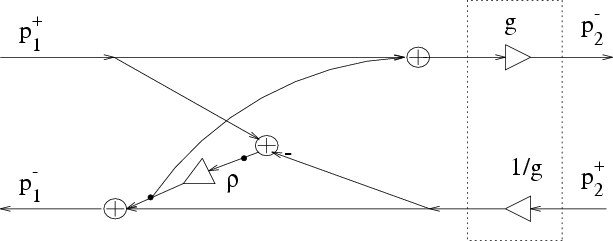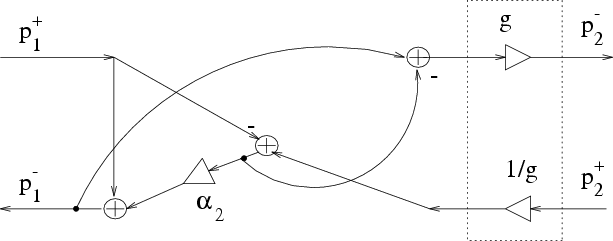 |
(74) |
A well known two-port unnormalized scattering junction [57],
implemented using one multiply and three adds, can be derived by
organizing (64) as
| (75) |
| (76) |
| (77) |
 |
 |
Note that a high quality sinusoidal oscillator requiring only one multiply can be formed by adding a unit delay on either side of a three-multiply junction and reflectively terminating (in which case the transformer multiplies cancel) [103].
One-multiply two-port scattering junctions enforce structural
losslessness in finite precision arithmetic since the allpass
complementarity condition (67) is always true. A normalized junction obtained by transformer-normalizing a
one-multiply junction is also structurally lossless, provided the
transformer multipliers are implemented in extended precision. In
practice, normalized junctions of this type are made passive by
using any non-amplifying rounding rule at the output. Denoting the
ideal transformer coefficients by
 and
and ![]() , the
passivity condition on the transformer with quantized coefficients
, the
passivity condition on the transformer with quantized coefficients
![]() and
and
![]() is
is
![]() , even in the time-varying case.
, even in the time-varying case.
Since one of the transformer coefficients is always greater than ![]() ,
fixed-point implementations require support for an integer part,
unlike the fractional fixed-point format used in most DSP chips.
Since the transformer commutes with the junction in the two-port case,
the larger coefficient can, without loss of generality,
be chosen to apply to the signal entering the junction.
As an example of the increased
internal dynamic range required, if
,
fixed-point implementations require support for an integer part,
unlike the fractional fixed-point format used in most DSP chips.
Since the transformer commutes with the junction in the two-port case,
the larger coefficient can, without loss of generality,
be chosen to apply to the signal entering the junction.
As an example of the increased
internal dynamic range required, if
![]() , the
transformer coefficients may become as large as
, the
transformer coefficients may become as large as
![]() .
If
.
If ![]() is the ``machine epsilon,'' i.e.,
is the ``machine epsilon,'' i.e.,
![]() for
typical
for
typical ![]() -bit two's complement arithmetic normalized to lie in
-bit two's complement arithmetic normalized to lie in
![]() , then the dynamic range of the transformer coefficients is
bounded by
, then the dynamic range of the transformer coefficients is
bounded by
![]() . In summary, while
transformer-normalized junctions trade a multiply for an add in the
two-port case, they require up to
. In summary, while
transformer-normalized junctions trade a multiply for an add in the
two-port case, they require up to ![]() % more bits of dynamic range
within the junction adders.
% more bits of dynamic range
within the junction adders.